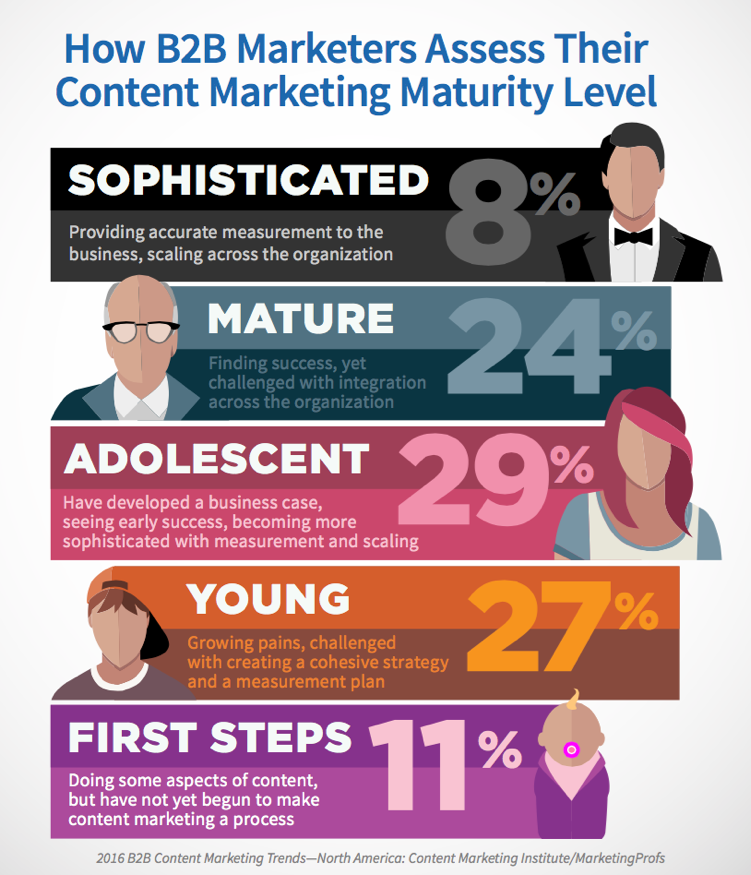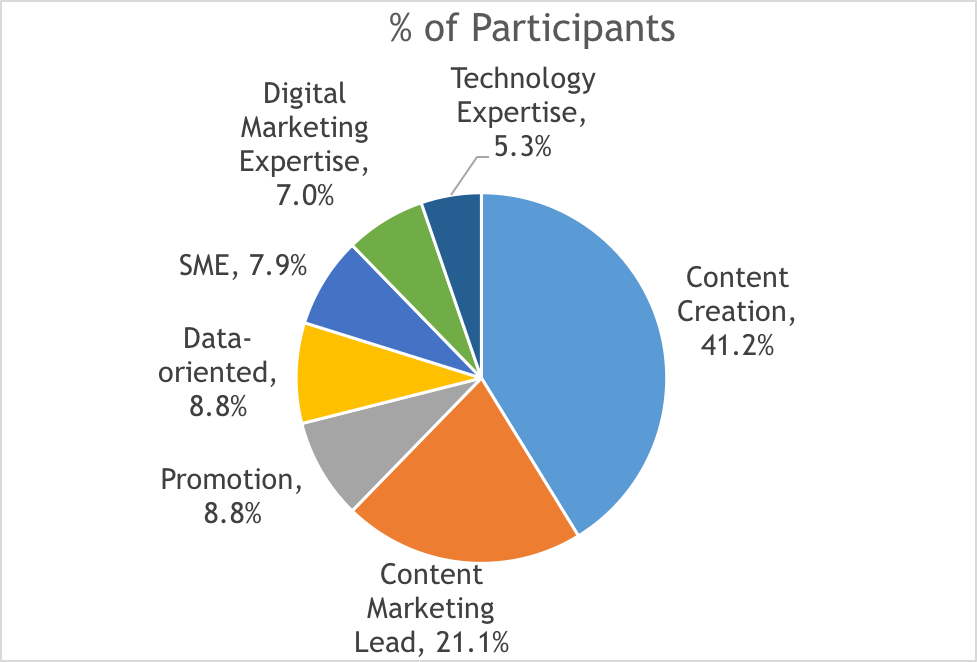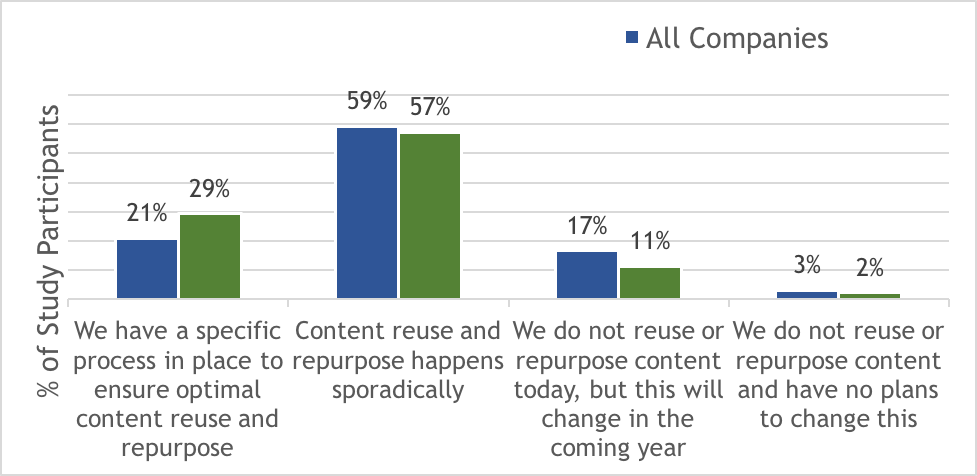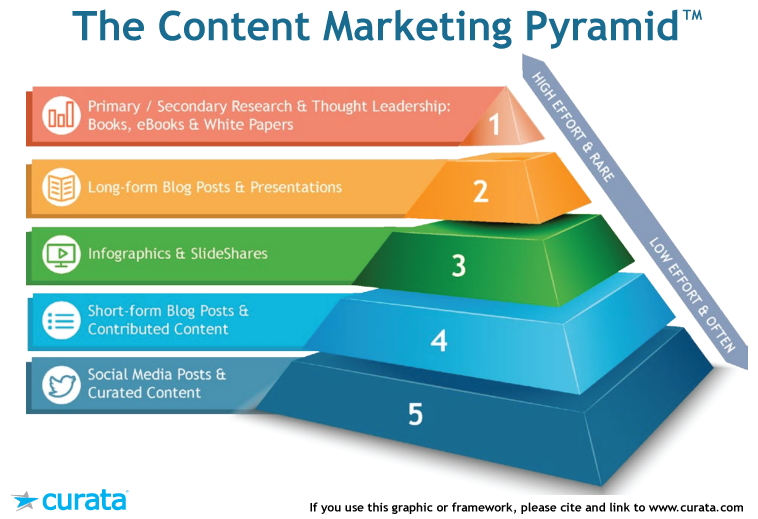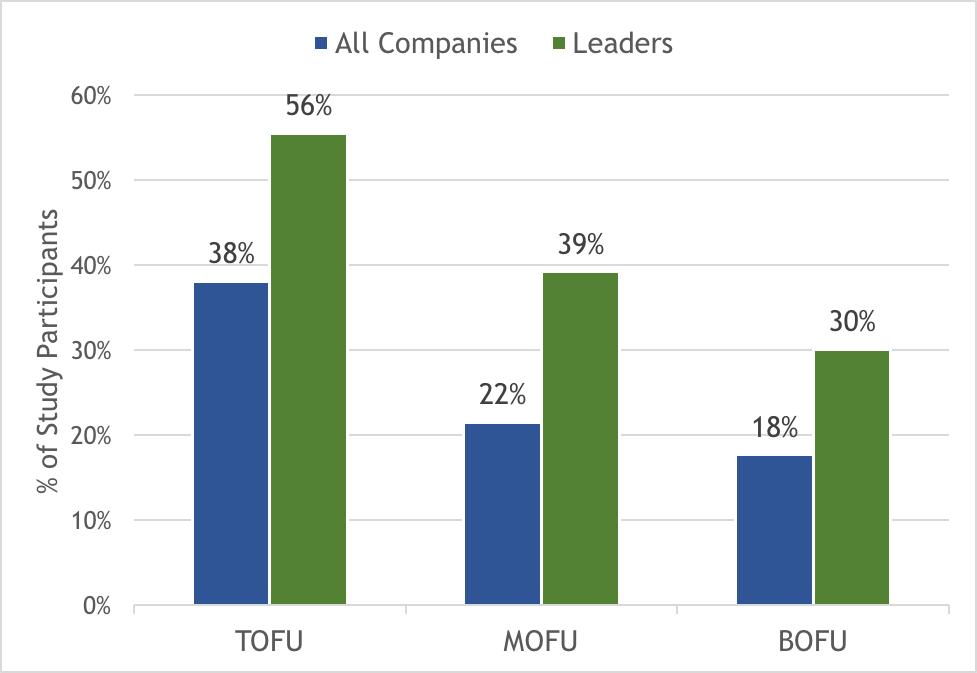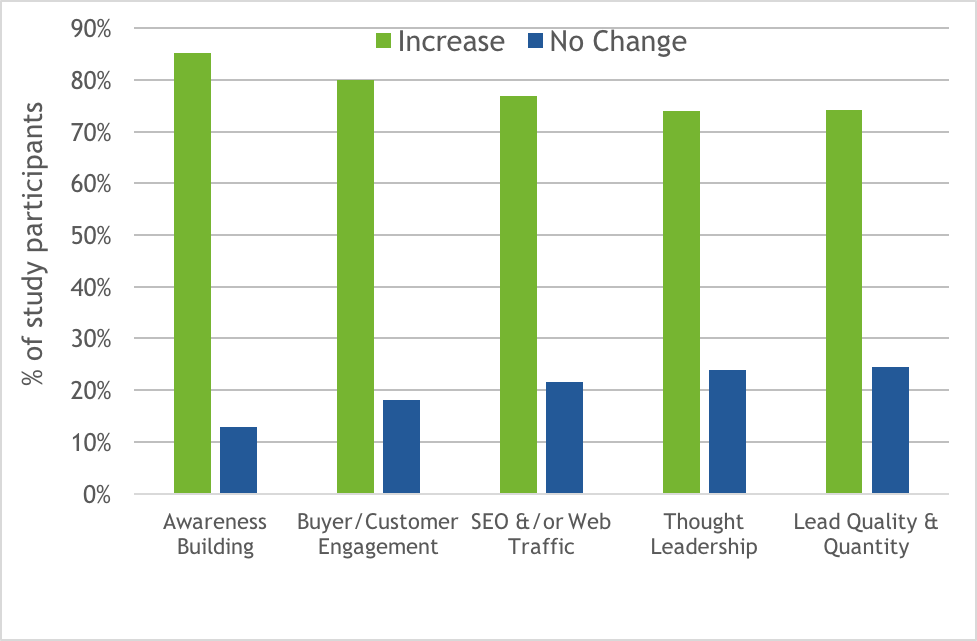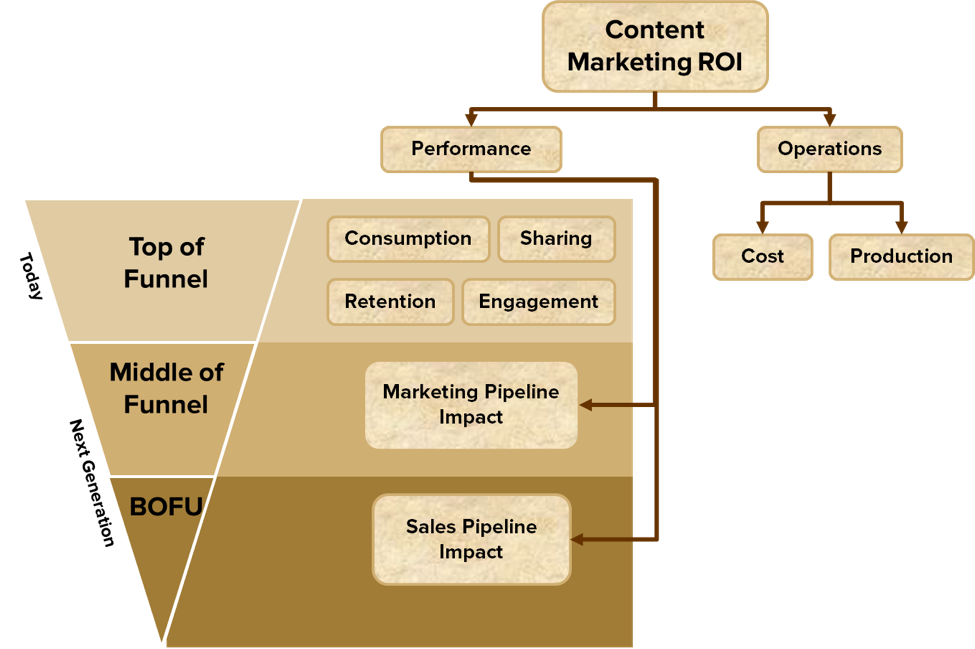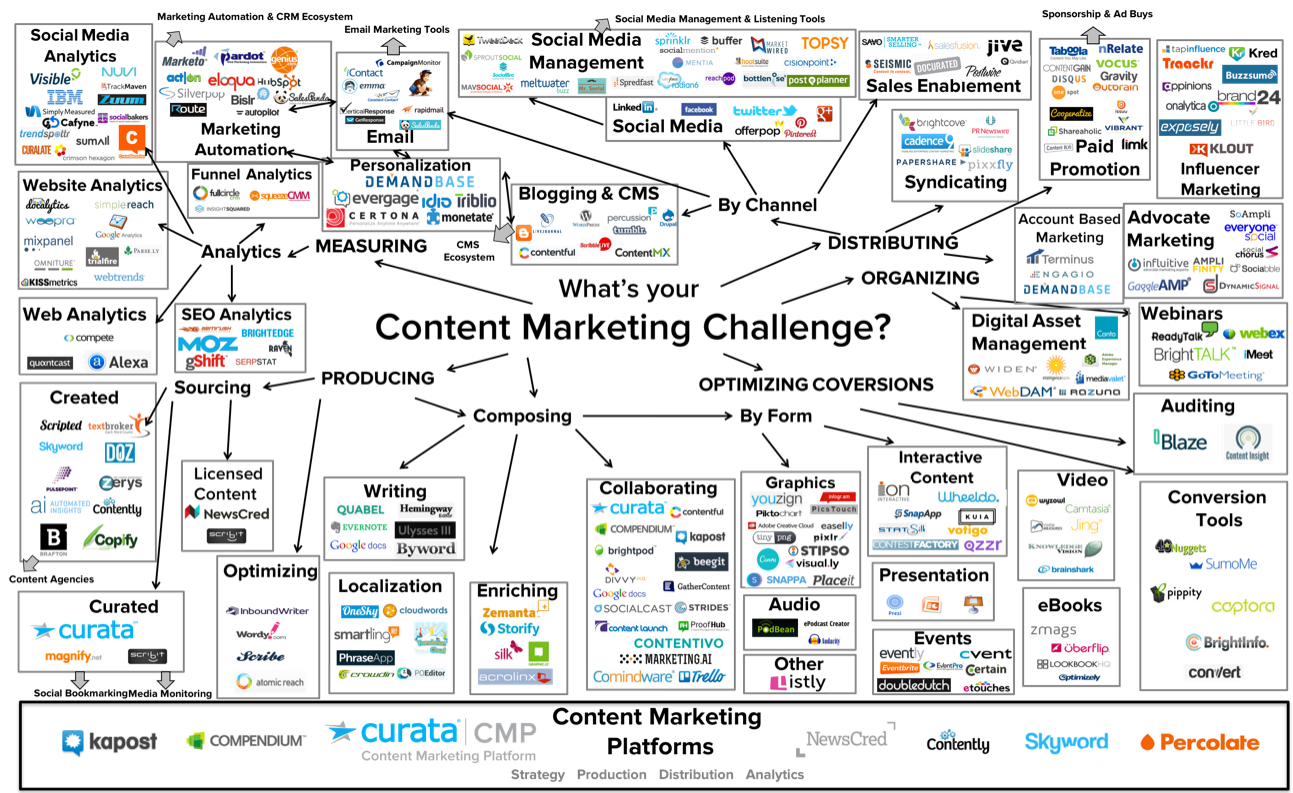- Share Content Marketing Strategy: Welcome to The Jungle on Facebook
- Share Content Marketing Strategy: Welcome to The Jungle on Twitter
- Share Content Marketing Strategy: Welcome to The Jungle on Linkedin
- Share Content Marketing Strategy: Welcome to The Jungle via email
The great news is that content marketing works! The best marketers know this, and are increasing their investment in content to drive leads and revenue. 75% of companies will make this increased investment in the coming year, and the most cunning and clever teams are driving the greatest return from their investment in content marketing strategy. We call these marketers the FOXES.
In this post I analyze the results of Curata’s recent survey of 1,000+ marketers to hone in on what these foxes are doing from a strategy, staffing and tactics perspective to kick ass with content. I share many of the staffing, process and technology benchmarks gleaned from the research, as well as what some of these foxes have to say about their own strategies. For a more in-depth presentation of the benchmark data and related guidance, download the entire eBook here: Content Marketing Staffing & Tactics Barometer.
Overview: Top 5 Content Marketing Strategy Areas to Focus On
We’re entering a new phase of content marketing. The marketers leading this pack are no longer focused on pure content volume or trying to hit the lottery with that one piece of content. These marketers—the foxes, are building the foundational elements of a practice that taps into the power of content to move an entire organization, versus simply a handful of people in a small corner of the marketing team.
More specifically, the foxes are focused on:
- Strengthening the content marketing team (e.g., 42% of companies have an executive responsible for content marketing).
- Creating a content marketing strategy (check out The Content Marketing Pyramid to see how we do this at Curata).
- Building out content marketing processes (i.e., production, distribution, analytics).
- Investing in content marketing technology (75% of foxes are increasing marketing technology investment).
 SCOTT ABEL
SCOTT ABELFounder, CEO, and chief strategist at The Content Wrangler, Inc. @ContentWrangler
“The single best practice that will set content marketers apart from the crowd is to focus on adopting intelligent content production efficiencies. The big challenge today is producing relevant content efficiently. It’s about scale, automation, and creating content the way factories create products: In a united, consistent, optimized way that provides the most bang for your content production buck.”
Survey Demographics
1,030 marketers participated in this survey. They were made up of:
- Participant Titles:
- CMOs and VPs of marketing made up 8.7% of respondents
- Marketing directors, managers and specialists were 45.9%
- Marketing consultants and agencies were 16.7%
- Marketing technology directors, managers and specialists were 9.1% of respondents
- Revenue:
- 54.4% of companies were <$10M by revenue
- 26.4% were $10M to >$100M
- 12.6% were $100M to <$1B
- 6.5% were $1B+
Content Marketing Works!
The new content marketing movement has had a significant impact on business, with 74% of companies increasing lead quality & quantity from their content. Marketing leadership is recognizing content’s positive impact, with 75% of companies increasing content marketing investment, and 43% increasing staff levels. However, the real work is just beginning.
Content marketing hype is coming to an end, indicating the beginning of its maturity across more organizations that will:
- Expand the strategic impact of content marketing efforts
- Fill skill-set gaps across teams
- Better leverage existing resources
- Get more rigorous on measuring content impact deep into the pipeline.
Content marketing is positively impacting the entire marketing & sales pipeline. Content continues to build awareness for organizations, and the best marketers are tapping into the power of content to more deeply engage leads, better influence sales opportunities and influence revenue growth.
 CHRIS GAEBLER
CHRIS GAEBLERChief Marketing Officer, Arbor Works @Chris_Gaebler
“Good content makes a point. Great content tells a story. Stories have tension and consider the humans involved. Start with the person, think about their struggles, and write.”
However, although content marketing has been growing significantly over the past three to five years, companies are only just starting to ramp up their efforts to take full advantage of the opportunities presented. As one example of the early stage content marketing is in, the average content marketing team consists of only three staff members.
Content Marketing is Still in the Infancy of Its Maturity
The Content Marketing Institute (CMI) and MarketingProfs’ 2016 content marketing study identified 32% of companies as being sophisticated or mature. This is similar to the 29% of companies considering themselves leaders in Curata’s study (i.e., the foxes).
Although roughly a third of companies are leading the pack, all companies have significant opportunity remaining by improving their content marketing practices. This covers many areas across people, process and technology.
Investment Continues to Grow
75% of companies are increasing content marketing investment, with 43% increasing staff levels. The 42% of companies with an executive responsible for content marketing will increase to 51% by 2017. Skill-sets being beefed up include writing (i.e., journalists), design professionals, and others.
This growth in staff is exciting and sorely needed as we enter a new phase of content marketing maturity. No longer are content marketing teams solely focused on trying to create one ‘home-run’ piece of content that garners thousands of shares and page views. This become too much of a lottery play. Now we’re focused on:
- Building a content marketing strategy that yields high quality content on a consistent basis
- Paying more attention to customers’ needs along the entire buying cycle
- Increasing relevancy by developing content focused on specific verticals, company sizes, and even specific accounts (e.g., supporting account-based marketing)
- Tapping into the reach of sales teams through sales enablement
- Learning what does and doesn’t work to get better and demonstrate impact
 ROBIN GOOD
ROBIN GOODWriter, speaker, change-agent, & publisher of MasterNewMedia.org @RobinGood
“What do I believe is the single best practice that will set apart the top content marketers from the rest of the field this year? The ability to move away from the classical article metaphor to create content that is not only useful, rich in resources, and well documented, but which also provides real information benefits to the reader, either in the form of a learning experience, of a starting point for new discoveries, or as a problem-solving resource. Doing this is not easy, nor is it going to save anyone time—quite the opposite. But those who invest time and resources to create such content will stand out for contributing something of such real value or inspiration to many that it will last to promote their brand for a very long time.”
What’s Your Content Marketing Spirit Animal?
When thinking about your own organization and its current efforts to thrive in the content marketing environment, do you think of your business as:
The Fox
Cunning, strategic, quick-thinking, adaptable, clever, and passionate, with the ability to use your resources for survival and growth.
The Wildebeest
Follows the pack, afraid of being left behind.
The Elephant
Strong, stable, and patient. Slow to shift to changing situations.
The T-Rex
Formerly powerful but rapidly on the way to extinction.
There are many different animals in the jungle, and some are better suited for survival than others.
 MONICA NORTON
MONICA NORTONSenior Director of Content Marketing at Zendesk @monicalnorton
“The content marketers that stand out from the crowd are risk-takers. They experiment. They never get too comfortable. If they don’t fail once in a while, they’re playing it too safe.”
So at a high level, what are the foxes up to?
Content Marketing Strategy in 2016
The majority of marketers (75%), plan to “increase” or “significantly increase” their content marketing budget in 2016. Accountability for this investment will increase in the next six to eighteen months as more rigor is applied to content’s pipeline impact.
The ability to respond in real-time—and not only newsjacking—is becoming more and more important. However, good planning provides the foundation from which you can respond most effectively, which is why having a great editorial calendar remains crucial. You can find the best in the Ultimate List of Content Marketing Editorial Calendar Templates.
 DAVID MEERMAN SCOTT
DAVID MEERMAN SCOTTMarketing strategist & bestselling author of The New Rules of Marketing & PR, and Newsjacking @dmscott
“Gone are the days when you could plan out your entire content marketing programs well in advance and release them on your timetable. It’s a real-time world now, and if you’re not engaged, then you’re on your way to marketplace irrelevance.”
Top 6 Content Marketing Challenges
- Limited budget (including staff)
- Creating enough content on a regular basis
- Finding the best sources to create amazing content
- Measuring the impact of content
- Organizational culture
- Promoting content
Companies continue to struggle with tapping into expertise across their organization to create compelling content, as well as recycling existing content into different formats across different channels.
Leading companies—the foxes—struggle with budget just like everyone else. However, they are more focused on finding sources for better content rather than creating enough content, and they don’t struggle as much with organizational culture supporting content marketing endeavors.
Other insight regarding these challenges includes:
- Limited budget and content, as well as source discovery, will become easier problems to resolve with organizational structure and process changes, along with content marketing technology.
- Measuring the impact of content is increasing in priority. The ability to measure the impact of content allows marketers to create more of what works and less of what doesn’t.
- Promoting content was ranked as the lowest marketing challenge. Promoting content helps marketers get the most out of what they create before creating more. Don’t forget to market your marketing, and don’t just leave it up to your social media team!
Guidance for addressing these challenges in this post and the related eBook are structured into a People, Process and Technology framework.
The Fox’s Content Marketing Strategy & Tactics: People
Leading marketers are focused on:
- Hiring a content marketing lead who will drive strategy and orchestrate the content marketing strategy across many marketing disciplines.
- Build out the team, focusing on the greatest skill-set gaps as detailed below.
- Improve staff alignment across the organization.
42% of Companies Have an Executive Responsible for Content Marketing Strategy
 Do you currently have an executive in your organization directly responsible for an overall content marketing strategy? (e.g., Chief Content Officer, VP or Director of Content)
Do you currently have an executive in your organization directly responsible for an overall content marketing strategy? (e.g., Chief Content Officer, VP or Director of Content)
Expectations for growth of this senior role were high in 2015, with 49% of companies expecting to have a lead for this role by the end of 2015. Growth has been slower than expected however. That said, this role exists at 42% of companies today with this expected to increase into 2017.
Of the foxes, 53% have this role in place today, versus 32% for the elephants and T-rex. Small companies with less than $10M in revenue, and large companies with $1 billion+ in revenue should see a 30% increase in staffing for the lead role in 2017.
Two thirds (68%) of these senior content marketing executives have global authority—a good sign given how important collaboration across an organization is for content creation and input, content reuse, and content distribution.
“Chief Content Officer” Not a Common Title for Content Marketing Executives
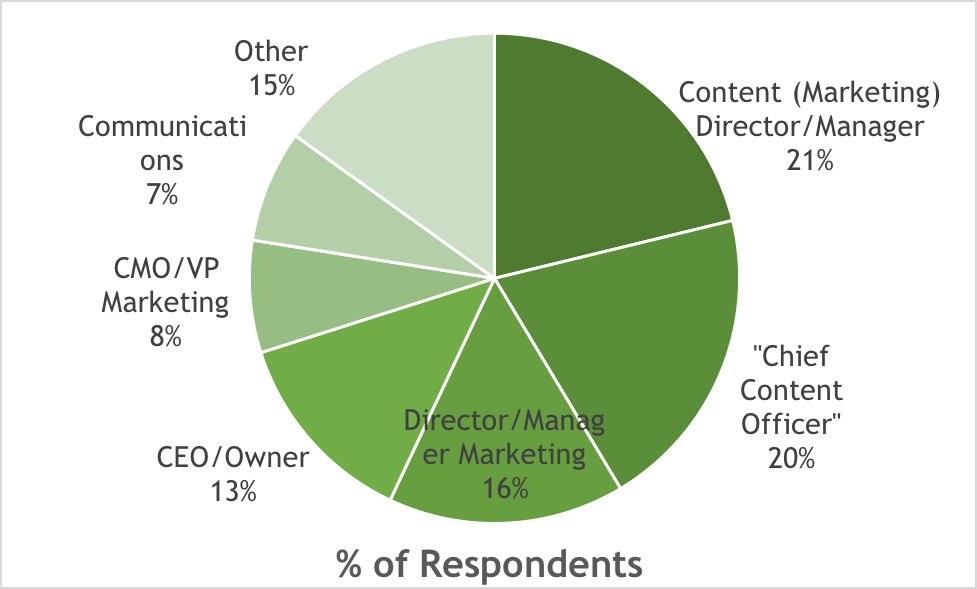 What is the exact title of the executive in your organization directly responsible for overall content marketing strategy?
What is the exact title of the executive in your organization directly responsible for overall content marketing strategy?
The most common title for content marketing executives is Content (Marketing) Director or Manager—not Chief Content Officer. Most folks titled Chief Content Officer are in agencies or publishing organizations. 68% of companies have up to three people on their content marketing team, and 42.5% of companies are increasing content marketing staff levels this year.
29% of $1 billion+ companies are struggling to align content marketing strategy across their teams, while small companies are leading the pack in content marketing alignment.
What’s the Greatest Skill-Set Missing From Today’s Content Marketing Team?
 JAY BAER
JAY BAERMarketing consultant, speaker, author of New York Times bestseller Youtility @jaybaer
“The best content marketers will think video first in every element of content marketing. Because if you have video, you have audio. And if you have audio, you have text (via transcription + editing). Video is now the seed corn for all great content marketing.”
Alignment Also Key Success Factor for Content Marketing Impact
 Please indicate how aligned your content marketing strategy and tactics are across internal teams (e.g., campaign management; social media; marketing operations; product marketing; regional/field marketing).
Please indicate how aligned your content marketing strategy and tactics are across internal teams (e.g., campaign management; social media; marketing operations; product marketing; regional/field marketing).
The Fox’s Content Marketing Strategy & Tactics: Process
Leading marketers are focused on:
- Creating a content marketing strategy (step-by-step provided in this webinar)
- Completing a content audit.
- Focusing content creation on segments and accounts. (e.g., account-based marketing)
- Reusing content. (e.g., using the Content Marketing Pyramid as a framework)
- Creating and curating content.
- Measuring content’s impact.
A common theme among foxes is stretching the dollar.
They’re asking themselves:
- What content do I already have?
- How can I reuse and repurpose content?
- How can I collaborate and curate?
Do You Know Which Content Exists Across Your Company, and Where It Is?
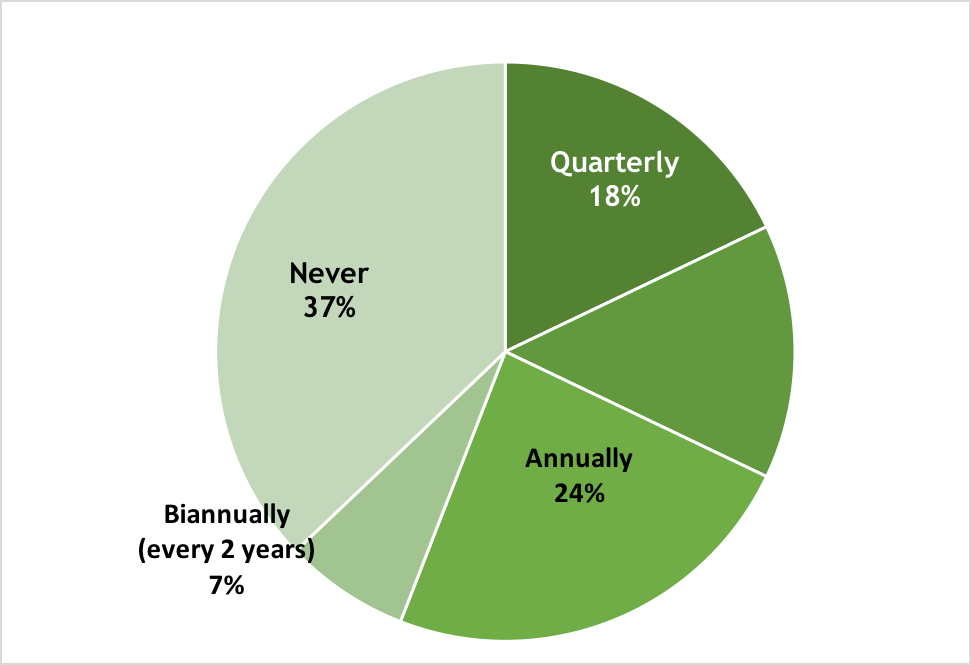 How often does your organization complete an audit of your company’s content?
How often does your organization complete an audit of your company’s content?
37% of content marketers never complete a content audit!
Reasons to Perform an Audit:
- Know what content you have and don’t have
- Focus content creation and curation efforts on gaps in content inventory
- Prevent investing in duplicate content
- Identify and then replace or remove outdated content
- Determine which content can be reused and repurposed
- Improve quality of existing content
Content Marketing Leaders Create Content for Individuals (Account-Based Marketing)
 BETH KANTER
BETH KANTERAuthor, trainer & nonprofit innovator in networks, learning, and social media @kanter
“The top content marketers understand their audience and why they want to consume content, and create and curate high quality content that helps them reach their goals.”
29% of Leading Marketers Systematically Reuse and Repurpose Content
The Content Marketing Pyramid
Use the Content Marketing Pyramid to execute a content campaign, assuring optimal content consumption, reuse and reach. For the full framework for developing and executing your content marketing strategy, download The Content Marketing Pyramid eBook.
 JASON MILLER
JASON MILLERBestselling author, global content marketing leader at Linkedin @JasonMillerCA
“The one single best practice that will set apart the top content marketers from the rest of the field in 2016 is… doing more with less by extracting every last bit of value from your existing content while striking a balance between data, creativity and your own personality for content creation moving forward.”
The Best Marketers Create AND Curate Content
Almost two-thirds of foxes (leaders) are curating content, with a similar percentage outsourcing content creation. Companies not taking advantage of these strategies are missing a HUGE opportunity to better leverage resources and more deeply engage with users. The recommended content mix is: 65% created, 25% curated and 10% syndicated content. Target one-third of your created content to be outsourced.
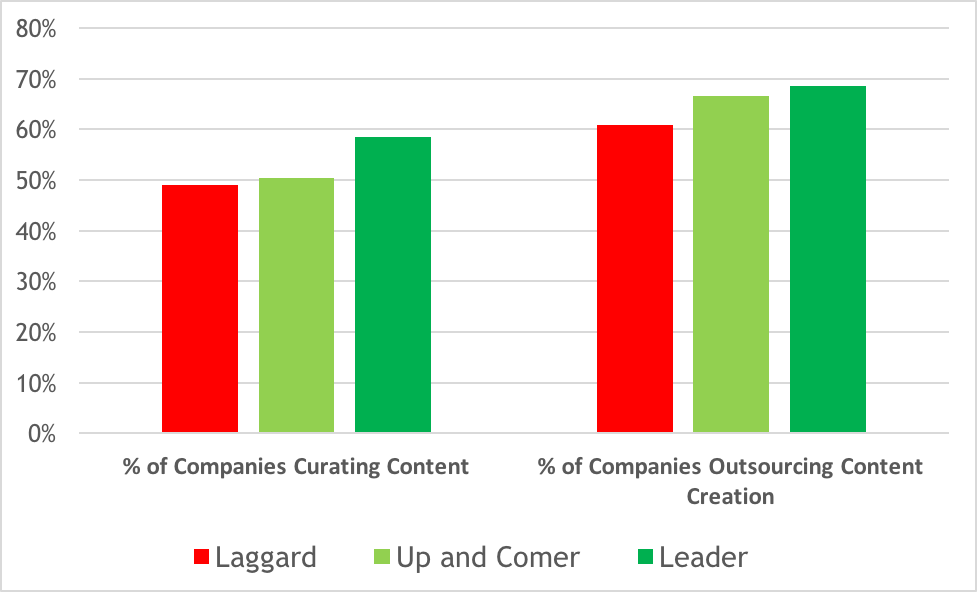 What percentage of companies are curating content or outsourcing created content?
What percentage of companies are curating content or outsourcing created content?
Additional reasons to outsource or curate content? To better leverage resources, improve the ideation process, better engage buyers through higher value content, and engage with your ecosystem.
What Exactly is Content Curation?
Content curation is when an individual (or team) consistently finds, organizes, annotates and shares the most relevant and highest quality digital content on a specific topic for their target market.
Have you ever published a “best of” post, commented on and shared a link on Twitter, or posted a link to Facebook with your commentary? Then you’ve curated!
To be clear, content curation done right is not pirating. Follow these 6 tips to curate content ethically:
- If you are reposting an excerpt from an original article, make sure your excerpt only represents a small portion of the original article.
- Always identify the original source and drive visitors to the original publication. 3. Retitle all content you curate.
- Don’t use no-follows on your links to an original publisher’s content.
- Inject some creativity and your own voice into your curation efforts. E.g. provide context for the material you use, add your own insight and/or guidance for your audience.
- Make your commentary longer than the excerpt you’re reposting.
To really curate like a rockstar, download The Ultimate Guide to Content Curation eBook.
Analytics
“Half the money I spend on advertising content marketing is wasted; the trouble is I don’t know which half.” – (with apologies to) John Wanamaker
The foxes are laser-focused on measuring the impact of content; to justify its impact on the organization as well as to drive continuous improvement. These leaders also get that content impacts the top, middle and bottom of the funnel if done right.
Content marketing leaders excel at performance measurement
 JIM LENSKOLD
JIM LENSKOLDMarketing expert, international speaker, president of Lenskold Group and author of Marketing ROI: The Path to Campaign, Customer and Corporate Profitability @JimLenskold
“Marketers with ROI-based measures will gain advantages as they maximize their financial performance. Content measures must go beyond engagement and leads to show contribution to both incremental sales and increased customer value.”
Seeing the Impact of Content
Estimate the impact of your company’s content marketing investment on the following areas during the past 12 months.
Content marketing has had the greatest impact on the top of the funnel (TOFU) so far. However, the foxes are seeing significant impact on MOFU & BOFU as well. They are looking at metrics across the funnel, from leads generated and influenced at the marketing-owned stages, to sales opportunities generated and influenced.
Time to Raise the Performance Measurement Bar
Data-driven content marketing is possible, and can yield significant results. For example, Curata used its own content marketing platform, integrated with Marketo and SF.com, to demonstrate that long form blog posts generate 9 times more leads than short form blog posts. (full blog post here) Investing in marketing technology makes this process possible.
The Fox’s Content Marketing Strategy & Tactics: Technology
There’s no doubt that the number of technology solutions continues to grow, as evident by the below Content Marketing Tools Universe figure below. 75% of foxes are increasing marketing technology investment in 2016 to take advantage of these new solutions. However, a key step in getting the greatest benefit out of this investment is integrating new software into your existing tech stack. 40% of companies have either “moderately” or “fully” integrated their marketing and sales force automation systems, compared with one third in 2015. 59% of foxes are dedicating effort to MAP and SFA integration.
Summary:
Content marketing is impacting ALL stages of the pipeline. The foxes get this, and as a result content marketing is entering a new phase of maturity. Don’t miss the boat!
- Build your content team: both internal and external. Take a Center of Excellence approach.
- Identify opportunities to stretch your content marketing budget (e.g., repurpose and reuse content, tap into content curation).
- Raise the performance measurement bar to go beyond measuring page views and social media. Dive deep into marketing pipeline impact and sales pipeline impact (examples here).
- Tap into the power of content marketing technology: Establish a closed-loop content supply chain, and integrate with marketing and sales automation (e.g., the content marketing platform is complementing marketing salesforce automation). And above all, don’t forget to have fun with it!




